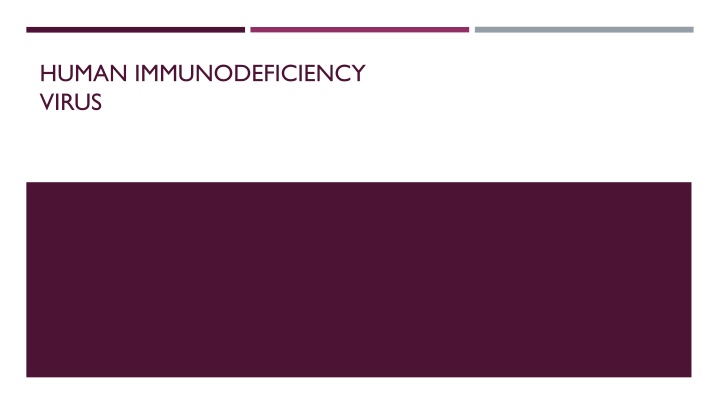
Human Immunodeficiency Virus (HIV) and Acquired Immunodeficiency Syndrome (AIDS)
Learn about HIV, the virus that causes AIDS, its structure, transmission routes, replication process, challenges in vaccine development, and more. Discover the classification, genome, and receptors of HIV for a comprehensive understanding of this infectious disease.
Download Presentation

Please find below an Image/Link to download the presentation.
The content on the website is provided AS IS for your information and personal use only. It may not be sold, licensed, or shared on other websites without obtaining consent from the author. If you encounter any issues during the download, it is possible that the publisher has removed the file from their server.
You are allowed to download the files provided on this website for personal or commercial use, subject to the condition that they are used lawfully. All files are the property of their respective owners.
The content on the website is provided AS IS for your information and personal use only. It may not be sold, licensed, or shared on other websites without obtaining consent from the author.
E N D
Presentation Transcript
HUMAN IMMUNODEFICIENCY VIRUS
OBJECTIVES What is the definition of AIDS ? Describe the structure of HIV ? What are the most common routes of transmission of HIV? How does HIV replicate and cause damage to the immune system? What problems are there in the development of an effective vaccine against AIDS?
Human immunodeficiency virus (HIV) is the cause of acquired immunodeficiency syndrome (AIDS) which defined as: HIV infection in an individual with a CD4+ cell count of <200 cells per cubic mm of blood.
Classification Retroviridae family Lentivirus subgroup Human immunodeficiency virus (HIV) types. HIV1 HIV2 HIV2 causes milder, slower to progress and poorly transmitted vertically. HIV1 causes most of the disease world wide (pandemic).
Structure of HIV Cylindrical nucleoid capsid protein: p24 two copies of single stranded, positive sense RNA . reverse transcriptase (RT), RNase H integrase and protease. A protein matrix underlying the envelope formed by p17.
The envelope : glycoprotein spikes (gp160) gp120 external major glycoprotein : binds to CD4 and coreceptors (CCR5 and CXCR4) gp41 a transmembrane segment mediate fusion between the cellular and viral membranes.
Genome Three structural genes : Gag (Group Specific Antigen) : p24, p7, p17 Env (Envelope) : gp 120, gp 41 Pol (Polymerase) : Reverse transcriptase, integrase, protease. Up to six Regulatory genes found in HIV
Receptors The virus is especially tropic to CD4+ T cells, but any cells expressing CD4 are susceptible to HIV infection ; like monocytes, macrophages, dendritic cells and microglia cells of the nervous system. A second coreceptor in addition to CD4 is necessary for HIV-1 to gain entry to cells, which is required for fusion of the virus with the cell membrane. CCR5 is the predominant coreceptor for macrophage-tropic strains of HIV-1. CXCR4, is the coreceptor for lymphocyte-tropic strains of HIV-1.
Tropism M- tropic strains of the virus predominates early in infection and its believed that macrophages and monocytes serves as major reservoir for HIV in the body, unlike the CD4+ T cells , the monocyte is relatively resistant to the cytopathic effect of HIV.
Transmission and Epidemiology sexual contact . Transfer of contaminated blood or blood products, I.V drugs. Perinatal transmission across placenta at birth 50% breast feeding Patients with sextually transmitted disease at higher risk. Screening of donated blood for HIV antibodies greatly reduce the HIV transmission. Blood banks now test for presence of p24 antigen.
Clinical stages 1.Acute 2.Latent 3.Disease
1. Acute stage a 4- to 11-day period between mucosal infection and initial viremia; which is detectable for about 8 12 weeks. Virus is widely disseminated throughout the body during this time, and the lymphoid organs become seeded. An acute mononucleosis-like syndrome develops in many patients 3 6 weeks after primary infection. There is a significant drop in numbers of circulating CD4 T cells at this early time. An immune response to HIV occurs 1 week to 3 months after infection, plasma viremia drops, and levels of CD4 cells rebound. However, the immune response is unable to clear the infection completely, and HIV-infected cells persist in the lymph nodes.
2. Clinical latency may last for as long as 10 years. The patient is asymptomatic. high level of ongoing viral replication. high turnover rates of CD4 T lymphocytes . the inherent error rate of the HIV reverse transcriptase
3.Clinical disease opportunistic infections or neoplasms. Higher viral load CD4 T cell counts have dropped to less than 200 cells/L more virulent and cytopathic a shift from (M-tropic) strains of HIV-1 to (T-tropic) variants accompanies progression to AIDS
Opportunistic Infections occur when the CD4 T cell counts have dropped to less than 200 cells/L (1) Protozoa: Toxoplasma gondii, Isospora belli, cryptosporidium species. (2) Fungi: Candida albicans, Cryptococcus neoformans, Coccidioides immitis, Histoplasma capsulatum, Pneumocystis jiroveci.
(3) Bacteria: Mycobacterium avium-intracellulare Mycobacterium tuberculosis, Listeria monocytogenes, Nocardia asteroides, salmonella species, streptococcus species. (4) Viruses: Cytomegalovirus, herpes simplex virus, varicella-zoster virus, adenovirus, polyomavirus JC virus, hepatitis B virus and hepatitis C virus.
AIDS-associated cancers include: Hodgkin's lymphoma and non-Hodgkin's lymphoma (both systemic and central nervous system types), Kaposi's sarcoma cervical cancer anogenital cancers
Laboratory Diagnosis Evidence of infection by HIV can be detected in three ways: (1) serologic determination of antiviral antibodies (2) PCR tests (3) Virus isolation (culture)
Serology Enzyme-linked immunoassay (ELISA) for detection of antibodies to p24 protein as a presumptive diagnosis. Western blot (Immunoblot) analysis a confirmation test is performed in which the viral proteins are displayed by acrylamide gel electrophoresis, transferred to nitrocellulose paper (the blot), and reacted with the patient s serum. The response pattern against specific viral antigens changes over time as patients progress to AIDS. Antibodies to the envelope glycoproteins (gp41, gp120, gp160) are maintained, but those directed against the Gag proteins (p17, p24, p55) decline. The decline of anti-p24 may herald the beginning of clinical signs and other immunologic markers of progression.
PCR test very sensitive and specific technique . plasma HIV RNA levels (Viral load) are important predictive markers of disease progression and monitor the effectiveness of antiviral therapies. Early diagnosis of HIV infection in infants born to infected mothers . The presence of maternal antibodies makes serologic tests uninformative. Low levels of circulating HIV-1 p24 antigen can be detected in the plasma by EIA soon after infection but, the antigen often becomes undetectable after antibodies develop (because the p24 protein is complexed with p24 antibodies) but may reappear late in the course of infection.
Culture HIV can be cultured from clinical specimens Is available only at a few medical centers because they are time-consuming and laborious limited to research studies.
Treatment No drug regimen results in a cure (eradication of the virus) but long term suppression can be achieved Treatment of HIV typically involves multiple antiretroviral because of high rate of mutation to drug resistance. Highly active antiretroviral therapy (HAART) the standard treatment consist of one of four regimen , all of which consist of a combination of at least three drugs that suppress HIV replication. HAART is effective in prolonging life, improving quality of life and reducing viral load.
Classes of drugs Nucleoside /Nucleotide reverse transcriptase inhibitors NRTIs Emtricitabine, Didanosine/Tenofovir Nonnucleosides Reverse Transcriptase Inhibitors efavirenz The protease inhibitors: are potent antiviral drugs because the protease activity is absolutely essential for production of infectious virus, and the viral enzyme is distinct from human cell proteases. When combined with nucleoside analogues are very effective in inhibiting viral replication and increasing CD4 cell count. Commonly used in HAART regimens. Ritonavir, Atazanavir
Fusion inhibitors blocks virus entry into cells. binds to viral gp41and blocks fusion of virus with cell membrane. enfuvirtide. Integrase inhibitors; inhibit integration of proviral DNA into cellular DNA Raltegravir
Prevention No vaccine is available. Multiple trial have failed to induce protective antibodies , protective cytotoxic T cells or mucosal immunity because HIV mutates rapidly, is not expressed in all cells that are infected, and is not completely cleared by the host immune response after primary infection.
Prevention Pre exposure prophylaxis PrEP Taking measures to avoid exposure to the virus e.g using condoms, not sharing needles, blood testing . Post exposure prophylaxis PEP, such as that given after a needle stick injury employ three drugs regimens given soon after exposure and continue for 28 days. To reduce HIV infection in children Antiretroviral therapy should be given to HIV infected mothers and neonates. Cesarean section lower the risk of neonatal infection than vaginal delivery. HIV infected mothers should not breast feed.




